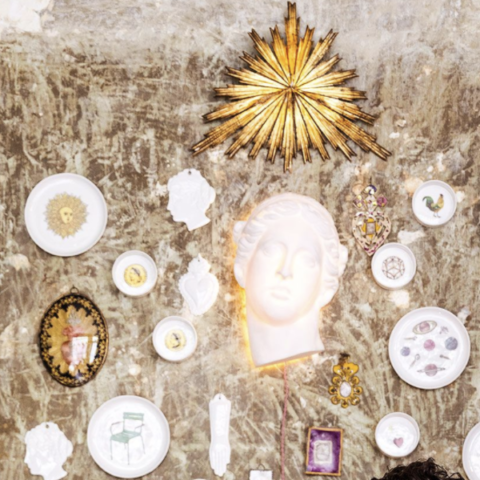A Fairytale for Christmas
By Jo Phillips
Once upon a time, there was a nobleman born in Paris on the 23rd of February, 1615. His name was Nicolas Fouquet. He grew up to live an incredible life, and this is his Christmas tale.
While still in his teens, he held several positions of local governmental responsibility, and in 1636, at only 20 years old, he was able to buy the post of maître des requêtes. It was a judicial officer of administrative law, a high-level position in France that has existed in one form or another over much of Europe since the Middle Ages. In 1640, he married the rather rich Louise Fourché, who sadly died only a year later.

This young entrepreneur toiled day and night and rose through the ranks, doing extremely well within the finance areas of the government. He also became close with the then King, Louis XIV. He also married well again in 1651 to Marie de Castille, who belonged to a wealthy family of the legal nobility in Spain, which played a massive part in the increase of his wealth.
After several years of success, he became the Superintendent of Finances in 1653, a position of enormous responsibility which involved negotiations with the great financiers. The palace was in great need of funds due to the cost of wars, which meant Nicolas even personally raised funds in order to aid the king. Despite the challenges, he succeeded in really turning the fortunes of France around under his leadership. He was also an avid patron of the arts, attracting many artists with his generosity: a man of wealth, standing, and good taste.

At 23, he had inherited a piece of land from his family. So, like any great nobleman of his time, he decided to build his own Chateau. Not uncommon, except our noble hero Nicolas Fouquet decided to build the most beautiful and forward-thinking house the whole of France had ever seen. So began the tale of Chateau de Vauxhall’s le Vicomte, only 33 km southeast from Paris, built strategically between Paris and the king’s other homes. The sorry tale of Nicolas Fouquet’s rapid social ascent and heartbreaking fall from grace begins here too. A fairytale in its truest sense.
Leaving nothing to chance, the dynamic character employed the best of the best for this creation; the architect Louis le Vau, head gardener Andre le Norte, and painter-decorator Charles le Bruno. Even within these three categories, each of the heads would employ specialists of their own.

For example, the inside walls of this great castle are full of hand-painted wooden panels. The ceilings are like the most divine ever to be seen, almost as famous and exquisite as the Sistine Chapel. So, when it came to painting flowers, a specialist flower painter was recruited. For each and every technique utilised, a specialist was bought in.
Before we progress with this story, this tale of love, laughter, and hijinks, towards its dynamic ending, we must overview this great castle.

To start with, it was of its day groundbreaking. The visual from front and back was created as an optical illusion, built to specific mathematical knowledge of the day. Louis Le Vau, the architect, had also trained at an art academy. With the growing knowledge of perspective in the arts at this time period, he was able to utilize this in the design, which can be seen with notable rooms like the oval salon which faced the garden, which is where the biggest of illusions take place.

The formal French gardens at 33 hectares were built on plateaus, helping the house with the almost Tromp L’Oeil effect. When standing from the house and gazing out to the gardens, there is the golden figure of Hercules in the distance. It looks as though the statue is only a ten or so minute walk away, but in fact, the layers of ground break the eye-line, giving an illusion. This great golden statue of Hercules is in fact about 45 minutes’ walk away. The plateaus foreshorten the view and play tricks on vision.
Get to the staus and look back on the house and you will have a different illusion. The house was built on either side symmetrical outhouses that include the sables yet from a distance the two sets of outbuildings look as if they are actually joined to the house when they are in fact separate buildings.

Inside, even simple features like the depth of the palace are not traditional. As a starting point, the thickness of the main body of the building, which consists of two rows of rooms running east and west. Traditionally, the middle of a French Chateau consisted of a single row of rooms.
Inside the home, no technology of the day was spared, and no craft or opulence either. It is literally floor to ceiling opulence. An early form of baroque, or rococo if you like, that was copied by many in the highest of society across Europe. The Chateau was even a forerunner to the great Versaille Palace.

There are ceiling tiles with plaster and painted over, which was considered radical at the time. Each room, of course, is different and at the time of building (it was never finished but more of that part of the fairytale later) there would have been the most exquisite and stunning expensive tapestries taffeta and luxury fabrics swaddling each room and set of windows. Look up at ceilings and see angles nymphs and squirrels literally hanging and climbing the walls and ceilings.

There is of course for our hero a coat of arms that came from the family. A squirrel and bore the motto “Quo nonascendet?” (“What heights will he not scale?”). This squirrel motif is planted all over walls and ceiling in many rooms throughout the chateau. And why a squirrel? because the animal’s name comes from the name family name Fouquet, which in the dialect of Angers (in the west of France) means squirrel.
As talked of earlier in our story, the dashing and dazzling Nicolas Fouquet was a massive supporter of the king, evening going so far to build a suite of rooms for the king mirror to his own stately rooms. At this time all chateaus would have a room for the king ( should he just happen to visit) but Nicolas took it one stage further, with this King’s replica suite of rooms a mirror to his own rooms
The king visited the site during building and was clearer aware of how the work was progressing and obviously became so impressed he went on to use the same Architect to build The Place of Versaille. However, as any good fairy tale goes there must be a ‘baddie”
In our tale, the baddie was a gentleman named Colbert. Jean-Baptiste Colbert was quite simply a jealous man who couldn’t bear seeing Nicolas Fouque succeed and wanting Fouque’s position for himself so fed the king lies against Fouquet. Suggesting he was not loyal to the king, and succeeding to plant a rotten seed in the then 20-year-old king’s mind.

And came the night of the opening party which the king is course attended (although he didn’t sleepover!) On the evening of August 17, 1661, Nicolas Fouquet hosted a lavish soirée to honor the king at his new estate, yet days earlier, Louis XIV had succumbed to Colbert’s lies and made his decision to imprison Fouquet.
However, on this party eve, the King walked through the gardens, dined, and enjoyed a theatre play ( a stage the very great Moliere was said to have played on) followed by fireworks, leaving before dawn.
Heartbreakingly, three weeks past before Fouquet was arrested in Nantes by d’Artagnan, captain of the King’s musketeers.
As this tale rapidly progresses in turns our story into the ‘trial of the century’ which ended up dragging on for three years!. This was mainly due to the judges, although hand-picked by the king there so little proof of treason, and when eventually finalised the judges voted to have him banished from France.
This tale of passion turned on a sixpence when King Louis XIV intervened, exercising his prerogative to overrule the judges and went on to impose a sentence of life imprisonment. This was the only time in French history a Monarch used his pardoning power to worsen the sentence, Fouquet was then incarcerated in Pignerol.
Sadly our dashing nobleman and the hero of our story died on March 23, 1680, and even having to this day never been pardoned with much misinformation still surrounding this real-life tale.
Maybe this fairytale is about a hero not being a man but our hero is this wonderful house Vauxhall’s le Vicomte. Not only does it still stand it is slowly but surely being restored to its glory.
The Chateau has, in fact, had several owners since Fouquet. Initially, Marshal de Villars, a famous military commander, acquired the property unseen and enjoyed it for a few years before it was sold by his son in 1764 to the Duc de Praslin. His descendants kept the estate for over a century before putting it up for auction in 1875. Sadly for 50 years, the château lay empty and neglected, its once magnificent garden grew wild,

But Alfred Sommier, who had built his fortune in sugar refining, enthusiastically took over the enormous task of returning the estate to its original splendour. And this is where the happily ever after comes to life in our romantic story. The family several generations down from Alfred, Patrice and Cristina de Vogue begin the arduous process of opening it to the public and over the years much has been done to restore the classic yet sublime french gardens, the house including restoring many of the roofs. Luckily they are now joined by their three sons who all play a part in rebuilding the legend, this time with the correct story.

Be welcomed into the site via black gothic gates with original stone plinths adorned with stone busts (with some still visibly square where the stonemason s never finished) see some are still partly square as they were never finished. Cross over the moat towards the front formal structure of the house. The gardens are restored to glory and are splendid. Whilst walking around each floor of the house is like bringing history alive.
One of the nicest elements of visiting the house is how exquisite each room is. Full of the splendor of days gone by from its origins of Nicholas’s day to some 18th and 19th-century updates. The workmanship and craft are so evident that kindly the family now provides comfortable seating in each room for those wishing to take the time to sit and truly engage with the artistry. Sit in the king’s original suite and see his writing desk, enjoy the depth of incredible artistry cocooning the room.
Visits are organised around four areas, decorated and furnished as if Nicolas Fouquet and his family had recently left the place. Composed of Nicolas Fouquet’s private apartments on the first floor, followed by the ceremonial salons on the ground floor and the staff rooms and kitchen in the basements.

There are stables, a coach museum, a shop and a restaurant (originally run by the present grandmother) and the palace is open March all the way through to Christmas. And OHHH Christmas what a treat!
In our collective imaginations and let’s be honest the Christmas season is all about fairytales; stories of rich princes glittering snow, shining stars and loving families. Did you ever wonder as a child what it would be like to be a fairy princess for a day? Or a king for that matter? What would it be like to walk around your own palace dressed in finery? Like it or not it’s a fairytale which actually can come true ..well if only for a day or a few hours

Well at Christmas this Palacios Chateau in France offers visitors the opportunity to actually dress up and walk around the splendid house and gardens dressed in the costume of the time to truly add to the depth of emotive experience available.

Come nightfall watch the back of the house with its light projection, and see the whole history from initial drawing from the architect to final Christmas decorations cover the whole expanse. It’s so worth being in the frosty gardens all lite with Gloden bulbs and giant golden squirrel.
This location is a work in progress as there is still so much the family plan to do. With no direct grants from the government, the family raise money to help with restoration, as well as charging the standard (Britsh fee) for entrance)

The whole adventure to Vauxhall’s le Vicomte is easy, take a train from Paris direct and then take a coach to the site. There are key seasonal events including Vaux-le-Vicomte celebrates Easter, Saturday nights from May to October for candlelight visits and fireworks, one-off events like 17th century day or European Heritage weekend and of course the magical Vaux-le-Vicomte celebrates Christmas. There are also very handy immersive headphone tours. The immersive sounds plunge visitors directly into the history, and into the heart of the story.

Discover everything you need to know at their website which is easily translated to several languages vaux-le-vicomte.com





